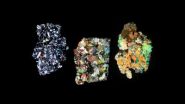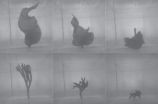(Press-News.org) ANN ARBOR, Mich.—A hidden facet of a math problem that goes back to Sanskrit scrolls has just been exposed by nanotechnology researchers at the University of Michigan and the University of Connecticut.
It turns out we've been missing a version of the famous "packing problem," and its new guise could have implications for cancer treatment, secure wireless networks, microelectronics and demolitions, the researchers say.
Called the "filling problem," it seeks the best way to cover the inside of an object with a particular shape, such as filling a triangle with discs of varying sizes. Unlike the traditional packing problem, the discs can overlap. It also differs from the "covering problem" because the discs can't extend beyond the triangle's boundaries.
"Besides introducing the problem, we also provided a solution in two dimensions," said Sharon Glotzer, U-M professor of chemical engineering.
That solution makes it immediately applicable to treating tumors using fewer shots with radiation beams or speeding up the manufacturing of silicon chips for microprocessors.
The key to solutions in any dimension is to find a shape's "skeleton," said Carolyn Phillips, a postdoctoral fellow at Argonne National Laboratory who recently completed her Ph.D. in Glotzer's group and solved the problem as part of her dissertation.
"Every shape you want to fill has a backbone that goes through the center of the shape, like a spine," she said.
For a pentagon, the skeleton looks like a stick-drawing of a starfish. The discs that fill the pentagon best will always have their centers on one of those lines.
Junctions between lines in the skeleton are special points that Glotzer's team refers to as "traps." The pentagon only has one trap, right at its center, but more complicated shapes can contain multiple traps. In most optimal solutions, each trap has a disc centered over it, Phillips said.
Other discs in the pattern change size and move around, depending on how many discs are allowed, but those over the traps are always the same. Phillips suspects that if a design uses enough discs, every trap will have a disc centered over it.
In their paper, published online today in Physical Review Letters, the researchers report the rules for how to find the ideal size and spacing of the discs that fill a shape. In the future, they expect to reveal an algorithm that can take the desired shape and the number of discs, or the shape and percentage of the area to be filled, and spit out the best pattern to fill it.
Extending the approach into three dimensions, Glotzer proposes that it could decide the placement of wireless routers in a building where the signal must not be available to a potential hacker in the parking lot. Alternatively, it could help demolition workers to set off precision explosions, ensuring that the blast covers the desired region but doesn't extend beyond a building's outer walls.
Phillips expects filling solutions to be scientifically useful as well. Glotzer's team developed the new problem by trying to find a way to represent many-sided shapes for their computer models of nanoparticles. In addition to nanotechnology, biology and medicine often need models for complex shapes, such as those of proteins.
"You don't want to model every single one of the thousands of atoms that make up this protein," Phillips said. "You want a minimal model that gives the shape, allowing the proteins to interact in a lock-and-key way, as they do in nature."
The filling approach may prove a perfect fit for a variety of fields.
### The paper is titled "Optimal filling of shapes." Funding for this study included grants from the Department of Energy and the Department of Defense
Sharon Glotzer: http://che.engin.umich.edu/people/glotzer.html
New twist on ancient math problem could improve medicine, microelectronics
2012-05-11
ELSE PRESS RELEASES FROM THIS DATE:
ICU stays for worst asthma drop 74 percent, review finds
2012-05-11
SAN ANTONIO (May 10, 2012) — A review of 30 years of life-threatening asthma cases in a San Antonio intensive care unit found that annual ICU admissions for the condition have dropped 74 percent. The study, by UT Medicine San Antonio physicians who reviewed cases at University Hospital between 1980 and 2010, also showed intubation in the emergency department to help patients breathe did not result in longer hospital stays.
UT Medicine is the clinical practice of the School of Medicine at The University of Texas Health Science Center San Antonio.
Faculty studied inpatient ...
UF study finds logging of tropical forests needn't devastate environment
2012-05-11
GAINESVILLE, Fla. — Harvesting tropical forests for timber may not be the arch-enemy of conservation that it was once assumed to be, according to a new study led by a University of Florida researcher.
Selective logging may be one of the few feasible options left for conserving tropical forests given the huge financial incentives pushing tropical landholders to convert primary forests into cash-generating agricultural plantations.
The report analyzed data from more than 100 studies of tropical forests on three continents that had been harvested for timber. Results ...
CNIO researchers describe a new target for developing anti-angiogenic and anti-tumoral therapies
2012-05-11
Researchers from the Spanish National Cancer Research Centre (CNIO), led by Jorge L. Martínez-Torrecuadrada from the Proteomics Unit, have demonstrated that the antibody-based blocking of ephrinB2, a protein involved in angiogenesis and lymphoangiogenesis, may represent an effective strategy for the development of antiangiogenic and antitumoural therapies.
The results of this study appeared in this month's issue of Blood, the journal of the American Society of Hematology.
CNIO researchers generated highly-specific human antibodies against ephrin-B2 using a phage display ...
Nanotube 'sponge' has potential in oil spill cleanup
2012-05-11
A carbon nanotube sponge that can soak up oil in water with unparalleled efficiency has been developed with help from computational simulations performed at the Department of Energy's (DOE's) Oak Ridge National Laboratory.
Carbon nanotubes, which consist of atom-thick sheets of carbon rolled into cylinders, have captured scientific attention in recent decades because of their high strength, potential high conductivity and light weight. But producing nanotubes in bulk for specialized applications was often limited by difficulties in controlling the growth process as well ...
New report illustrates impact of sequestration to medical research
2012-05-11
The report "Sequestration: Health Research at the Breaking Point," released today by Research!America, demonstrates the damaging consequences of potential automatic spending cuts, or sequestration, to the nation's medical research enterprise and public health, and offers examples on how these cuts would delay scientific discoveries that could lead to new treatments and cures for deadly diseases.
This report provides:
The estimated budget cuts to the National Institutes of Health, the Centers for Disease Control and Prevention, the Agency for Healthcare Research and ...
Dawn reveals complexities of ancient asteroidal world
2012-05-11
TEMPE, Ariz. – New findings from NASA's Dawn spacecraft lay the groundwork for the first geological overview of asteroid (4)Vesta and confirm the existence of not one but two giant impact basins in its southern hemisphere. The findings, published today in a set of Science papers, will help scientists better understand the early solar system and processes that occurred as it formed and evolved.
The Dawn spacecraft, orbiting asteroid Vesta since July 2011, has already acquired several thousand images of the asteroid's surface, revealing a complex landscape. The images ...
Patients see benefits and risks to direct-to-consumer genetics tests
2012-05-11
MAYWOOD, Ill. – Patients see potential benefits from direct-to-consumer genetic testing, but are also concerned about how test results will be used, and generally are unwilling to pay more than $10 or $20 for them, according to focus groups conducted by researchers at Loyola University Chicago Stritch School of Medicine.
Findings by first author Katherine Wasson, PhD, MPH, and colleagues are published in the American Journal of Bioethics Primary Research. Wasson, an assistant professor in Loyola's Neiswanger Institute for Bioethics and Health Policy, is an expert on the ...
New research on seaweeds shows it takes more than being flexible to survive crashing waves
2012-05-11
Seaweeds are important foundational species that are vital both as food and habitat to many aquatic and terrestrial shore organisms. Yet seaweeds that cling to rocky shores are continually at risk of being broken or dislodged from their holds by crashing waves with large hydrodynamic forces. So how do such seaweeds survive in intertidal zones? Do they have special properties that make them extremely flexible or particularly strong?
Patrick Martone (University of British Columbia) has spent a considerable amount of time standing on the shore watching big waves crash ...
You're beautiful, Vesta
2012-05-11
When UCLA's Christopher T. Russell looks at the images of the protoplanet Vesta produced by NASA's Dawn mission, he talks about beauty as much as he talks about science.
"Vesta looks like a little planet. It has a beautiful surface, much more varied and diverse than we expected," said Russell, a professor in UCLA's Department of Earth and Space Sciences and the Dawn mission's principal investigator. "We knew Vesta's surface had some variation in color, but we did not expect the diversity that we see or the clarity of the colors and textures, or their distinct boundaries. ...
A push from the Mississippi kept Deepwater Horizon oil slick off shore, Penn research shows
2012-05-11
PHILADELPHIA — When the Deepwater Horizon drilling rig exploded April 20, 2010, residents feared that their Gulf of Mexico shores would be inundated with oil. And while many wetland habitats and wildlife were oiled during the three-month leak, the environmental damage to coastal Louisiana was less than many expected, in part because much of the crude never made it to the coast.
Research by a trio of geoscientists, including the University of Pennsylvania's Douglas Jerolmack, now offers an explanation for why some of the oil stayed out at sea. Using publicly available ...

